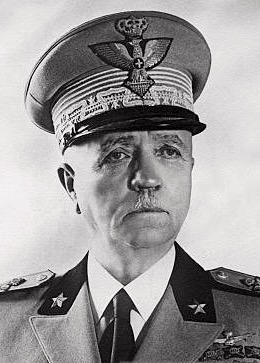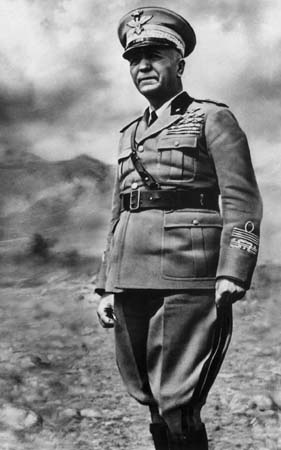Pietro Badoglio facts for kids
Quick facts for kids
Marshal
Pietro Badoglio
|
|
|---|---|
 |
|
| Prime Minister of Italy | |
| In office 25 July 1943 – 8 June 1944 |
|
| Monarch | Vittorio Emanuele III |
| Lieutenant General | The Prince of Piedmont |
| Deputy | Palmiro Togliatti |
| Preceded by | Benito Mussolini |
| Succeeded by | Ivanoe Bonomi |
| Minister of Foreign Affairs | |
| In office 11 February 1944 – 8 June 1944 |
|
| Prime Minister | Himself |
| Preceded by | Raffaele Guariglia |
| Succeeded by | Ivanoe Bonomi |
| Minister of the Italian Africa | |
| In office 11 February 1944 – 8 June 1944 |
|
| Prime Minister | Himself |
| Preceded by | Melchiade Gabba |
| Succeeded by | Ivanoe Bonomi |
| Governor-General of the Italian East Africa Viceroy of Ethiopia |
|
| In office 9 May 1936 – 11 June 1936 |
|
| Monarch | Vittorio Emanuele III |
| Duce | Benito Mussolini |
| Preceded by | Offices established |
| Succeeded by | Rodolfo Graziani |
| Commissary of the Italian East Africa | |
| In office 28 November 1935 – 9 May 1936 |
|
| Preceded by | Emilio De Bono |
| Succeeded by | Office abolished |
| Governor of Eritrea | |
| In office 22 November 1935 – 9 May 1936 |
|
| Preceded by | Emilio De Bono |
| Succeeded by | Alfredo Guzzoni |
| Governor of Tripolitania and Cyrenaica | |
| In office 24 January 1929 – 31 December 1933 |
|
| Preceded by | Emilio De Bono (Tripolitania) Attilio Teruzzi (Cyrenaica) |
| Succeeded by | Italo Balbo (Governor of Libia) |
| Personal details | |
| Born | 28 September 1871 Grazzano Monferrato, Piedmont, Kingdom of Italy |
| Died | 1 November 1956 (aged 85) Grazzano Badoglio, Piedmont, Italy |
| Political party | Independent |
| Spouse |
Sofia Valania
(m. 1884–1942) |
| Military service | |
| Allegiance | |
| Branch/service | |
| Years of service | 1892–1943 |
| Rank | Marshal of Italy |
| Battles/wars | First Italo–Ethiopian War Italo–Turkish War World War I Pacification of Libya Second Italo–Ethiopian War World War II |
Pietro Badoglio (born September 28, 1871 – died November 1, 1956) was an important Italian general. He served during both World War I and World War II. He also became the first viceroy of Italian East Africa. After the Fascist regime in Italy ended, he became the Prime Minister of Italy.
Contents
Early Life and Military Career
Pietro Badoglio was born in 1871. His father, Mario Badoglio, owned a small amount of land. His mother, Antonietta Pittarelli, came from a middle-class family.
In 1888, Pietro joined the Royal Military Academy in Turin. He became a second lieutenant in 1890. By 1892, he finished his studies and was promoted to first lieutenant.
After his training, he joined the Regio Esercito (Italian Royal Army) in 1892. He started as a lieutenant in the artillery. Badoglio took part in the First Italo–Ethiopian War and the Italo–Turkish War.
World War I Service
When Italy joined World War I, Badoglio was a Lieutenant Colonel. He quickly rose through the ranks. He became a Major General after successfully capturing Monte Sabotino in May 1916.
By late 1917, he was a Lieutenant General. He was named Vice Chief-of-Staff. He was involved in the events leading to the Battle of Caporetto in October 1917. After the war, he worked to explain his role in the defeat. A special group looked into the criticisms against him and found most of them were not true.
Governing Libya
After World War I, Badoglio became a Senator. He also continued to work for the army. He had special assignments in Romania and the United States in 1920 and 1921.
At first, he was not a supporter of Benito Mussolini. After 1922, he was sent away as an ambassador to Brazil. However, he soon changed his mind and returned to Italy. He took on a senior role in the army as Chief of Staff in May 1925. In June 1926, Badoglio was promoted to the highest rank: Marshal of Italy.
From 1929 to 1933, Badoglio was the governor of Tripolitania and Cyrenaica. These areas later became Italian Libya. During his time as governor, he worked to end local resistance. By 1932, he announced that the resistance had ended.
Italian Invasion of Ethiopia
In October 1935, Badoglio took over as commander of the Italian forces in the Second Italo–Ethiopian War. Mussolini thought the invasion was moving too slowly.
Badoglio led the Italian army in several battles. These included the First Battle of Tembien, the Battle of Amba Aradam, the Second Battle of Tembien, and the Battle of Shire. In March 1936, Badoglio defeated Emperor Haile Selassie's army at the Battle of Maychew.
By April 1936, there was no more Ethiopian resistance. Badoglio began his "March of the Iron Will" to capture the capital city, Addis Ababa. On May 2, Haile Selassie left the country.
On May 5, 1936, Marshal Badoglio led Italian troops into Addis Ababa. King Victor Emmanuel was declared the Emperor of Ethiopia. Ethiopia became part of the Italian Empire. Badoglio was made the first Viceroy and Governor General of Ethiopia. He was also given the special title of Duke of Addis Abeba.
In June 1936, Rodolfo Graziani replaced Badoglio as Viceroy. Badoglio returned to his job as the Supreme Chief of the Italian General Staff.
Role in World War II

Badoglio was the Chief of Staff from 1925 to 1940. He was in charge of the entire Italian Armed Forces. This included how they were organized, how officers were chosen, and what weapons they used. He did not object when Mussolini and the King decided to declare war on France and Great Britain.
However, the Italian army did not perform well in the invasion of Greece in December 1940. Because of this, Badoglio resigned from the General Staff. Ugo Cavallero took his place.
By early 1943, many military leaders believed Italy needed to stop fighting in the war. They felt Mussolini had to leave power because he would not agree to an armistice. King Victor Emmanuel III decided to replace Mussolini. He chose Badoglio to be the new prime minister. Badoglio had served Mussolini loyally but was also upset with him for blaming him for the failed invasion of Greece.
On July 24, 1943, after the Allied invasion of Sicily, Mussolini's government faced a vote of no confidence. The next day, King Victor Emmanuel III removed Mussolini from power and had him arrested. Badoglio was then named Prime Minister of Italy.
On September 3, 1943, an armistice (a peace agreement) was signed with the Allies. Badoglio was careful about announcing this agreement.
On September 8, 1943, the Allies announced the armistice themselves. This surprised many Italian military units. They were not ready for the German forces to disarm them. Early the next day, Badoglio, King Victor Emmanuel, and other leaders escaped to Pescara and Brindisi to seek Allied protection.
A longer version of the armistice was signed on September 23, 1943. On October 13, Badoglio and the Kingdom of Italy officially declared war on Nazi Germany. Badoglio continued to lead the government for another nine months.
On June 9, 1944, after the Allies captured Rome, Badoglio was replaced by Ivanoe Bonomi.
Later Life
Pietro Badoglio passed away in Grazzano Badoglio on November 1, 1956.
See also
 In Spanish: Pietro Badoglio para niños
In Spanish: Pietro Badoglio para niños
- Royal Italian Army
- Royal Italian Army (1940–1946)
- Italian Co-Belligerent Army

